![]()
![]()
![]()
Use LEFT and RIGHT arrow keys to navigate between flashcards;
Use UP and DOWN arrow keys to flip the card;
H to show hint;
A reads text to speech;
54 Cards in this Set
- Front
- Back
|
What happens to cell in 1st stage of mitosis
|
Interphase
(technically not part of mitosis, but it is included in the cell cycle) Cell is in a resting phase, performing cell functions DNA replicates (copies) Organelles double in number, to prepare for division |
|
|
Prophase
Spindle forms Centrioles move to opposite poles Chromosomes become visible |
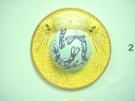
What stage is this, what happens?
|
|
|
Metaphase
Chromosomes line up along the equator |
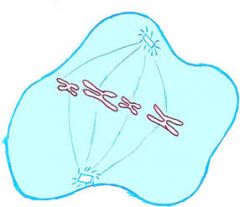
What stage of mitios is this? what happens
|
|
|
Anaphase
Centromeres divide Chromatids separate and move to opposite poles |

What stage of mitios is this? what happens
|
|
|
Nuclear membrane forms around each group of chromosomes
Chromosomes unwind Cytokinesis begins |
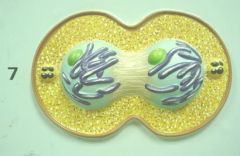
What stage of mitosis is this what happens?
|
|
|
Interphase is the same in both mitosis and meiosis, but in meiosis, it is followed by two cell divisions. These two division processes are referred to as Meiosis I and Meiosis II, and result in a total of four daughter cells, each with a 1n chromosome number
|
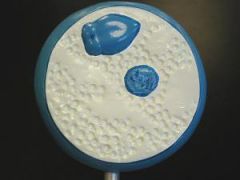
what stage of meoisis is this what's happening?
|
|
|
In prophase I, notice the difference in how the homologous chromosomes behave. They come together and match up (synapsis) in pairs (tetrads or bivalents). In human females, this stage happens prior to birth when the ovaries are forming, and then stops. A baby girl is born with all the precursor egg cells she will ever have in a sort-of "suspended animation" until puberty (hence abdominal x-rays are dangerous for any young to middle-aged human female, not just pregnant women, and hence there is a greater likelihood that a 40-yr-old mother will have a baby with Down Syndrome – due to incorrect meiosis — than a 20-yr-old mother
|
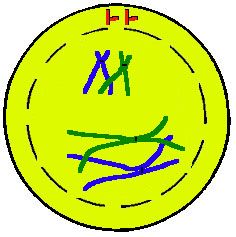
what stage of meoisis is this what's happening?
|
|
|
metaphase I-Bivalents, each composed of two chromosomes (four chromatids) align at the metaphase plate. The orientation is random, with either parental homologue on a side. This means that there is a 50-50 chance for the daughter cells to get either the mother's or father's homologue for each chromosome
|
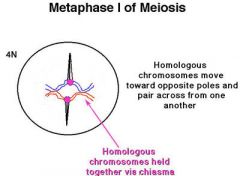
what stage of meoisis is this what's happening?
|
|
|
Chiasmata separate. Chromosomes, each with two chromatids, move to separate poles. Each of the daughter cells is now haploid (23 chromosomes), but each chromosome has two chromatids
|
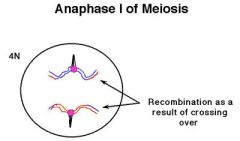
what stage of meoisis is this what's happening?
|
|
|
Telophase I
Nuclear envelopes may reform, or the cell may quickly start meiosis 2. |
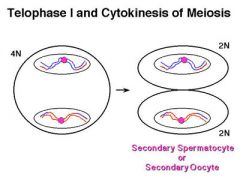
What stage of meosis is this?
|
|
|
What happens in meosisII?
|
Meiosis 2 is similar to mitosis. However, there is no "S" phase. The chromatids of each chromosome are no longer identical because of recombination. Meiosis II separates the chromatids producing two daughter cells each with 23 chromosomes (haploid), and each chromosome has only one chromatid.
|
|
|
anaphase
|
a phase of mitosis and meiosis in which the chromosomes
separate (150) |
|
|
asexual reproduction
|
the production of offspring that does not involve the
union of gametes (156) |
|
|
autosome
|
a chromosome that is not a sex chromosome (146
|
|
|
binary fission
|
an asexual cell division of prokaryotes that produces identical
offspring (148) |
|
|
cell cycle
|
the events of cell division; includes interphase, mitosis, and
cytokinesis (149) cytokinesis the division of the cytoplasm of one cell into two new cells (149) |
|
|
centriole
|
a structure that appears during mitosis in animal cells (150)
centromere a region of the chromosome where the two sister chromatids are held together and which is the site of attachment of the chromosome to the spindle fibers during mitosis (146 |
|
|
cell plate
|
a membrane that divides newly forming plant cells following
mitosis (151) |
|
|
chromatid
|
one of two identical parts of a chromosome (146)
|
|
|
centrosome
|
a dark body containing a centriole in animal cells but not in plant
cells; spindle fibers radiate from the centrosome in preparation for mitosis (150) |
|
|
cleavage furrow
|
the area of the cell membrane that pinches in and eventually
separates the dividing cell (151) |
|
|
crossing-over
|
the exchange of genes by reciprocal segments of homologous
chromosomes during meiosis (153) |
|
|
diploid
|
a cell that contains both chromosomes of a homologous pair (147)
|
|
|
gamete
|
a reproductive cell (153)
|
|
|
genetic recombination
|
the new mixture of genetic material after crossing-over
has taken place (154) |
|
|
G0 phase
|
a phase of the cell cycle in which the cell is not dividing and its DNA
is not replicating (149) |
|
|
G1 phase
|
the first period of interphase, in which the cell doubles in size (149)
|
|
|
G2 phase
|
the final period of interphase, in which the cell undergoes rapid
growth and prepares for mitosis (149) |
|
|
haploid
|
having only one chromosome of each homologous pair (147)
|
|
|
histone
|
a protein molecule that DNA wraps around during chromosome
formation (145) |
|
|
homologous chromosome
|
one of a pair of morphologically similar
chromosomes (146) |
|
|
independent assortment
|
during meiosis, the random distribution of genes
from different chromosomes to the gametes (154) |
|
|
interphase
|
a period of cell growth and development that precedes eukaryotic
cell nuclear division (149 |
|
|
karyotype
|
a picture of an individual’s chromosomes (147)
|
|
|
kinetochore fiber
|
a spindle fiber that extends from the centrosome at one pole
of the cell to a chromatid during mitosis (150 |
|
|
kinetochore
|
a disk-shaped protein found in the centromere region of a
chromosome that attaches the chromosomes to the mitotic spindle (150) |
|
|
meiosis
|
the process of nuclear division that reduces the number of
chromosomes in a cell by half (148) |
|
|
metaphase
|
the second phase of mitosis, during which all the chromosomes
move to the cell’s equator (150) |
|
|
mitosis
|
eukaryotic nuclear division (148)
|
|
|
mitotic spindle
|
the array of spindle fibers that serve to divide the chromatids
during nuclear division (150) |
|
|
M phase mitosis
|
the phase of cell division in which the nucleus divides (148)
|
|
|
polar body
|
one of two small cells produced and discarded during each of the
two meiotic divisions that yield the haploid egg (156) |
|
|
polar fiber
|
fibers that extend across a dividing cell from centrosome to
centrosome (150) |
|
|
oogenesis
|
the production of mature egg cells (155)
|
|
|
prophase
|
the first stage of mitosis and meiosis, characterized by condensation
of chromosomes (150) |
|
|
sex chromosome
|
a chromosome that determines sex (146)
|
|
|
sexual reproduction
|
the production of offspring from the combination of
genetic material from two parent organisms (156) |
|
|
spermatid
|
in meiosis, a haploid cell that develops into a mature sperm
cell (156) |
|
|
spermatogenesis
|
the production of sperm cells (155)
|
|
|
S phase
|
the second period of interphase during which replication of DNA
occurs (149) |
|
|
spindle fiber
|
one of the microtubules that extend across a dividing eukaryotic
cell; assists in the movement of chromosomes (150) |
|
|
synapsis
|
the pairing of homologous chromosomes during meiosis (153)
|
|
|
telophase
|
the final stage of mitosis during which a nuclear membrane forms
around each set of new chromosomes (151) |
|
|
tetrad
|
a group of two homologous chromosomes during meiosis (153)
|

